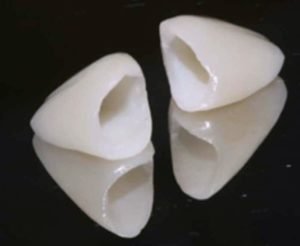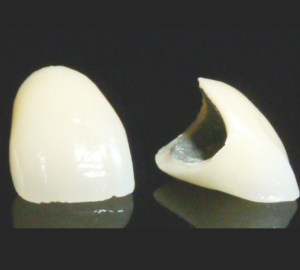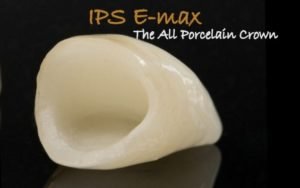Porcelain Fused to Metal [PFM] – When a tooth is badly broken or carious but it can still be saved, a crown would be recommended by the dentist to save the tooth from further damaged. An intervention to capped the tooth intends to prolong the life of the tooth and makes it useful again for chewing and to preserve the facial esthetic and prevent disruption of tooth position in the dental arch.
This type of artificial crown replacement is usually fabricated in the dental laboratory. It has an inner core made of rigid metal which is casted in high heating oven in the laboratory. The inner core material could be made of gold or other precious metallic alloy. Casted core or metal support could be either single or multiple as in bridged type { multiple porcelain crowns} with porcelain facing build up over its surface.. Gold is much preferred but one of its drawback is its processing cost plus the dentist clinical skills. Not all dentists have same skills and trainings in dental prosthetics. It is tempered by time of practice, seminars attended ,trainings and post graduate received courses received through the years.
Tilite Crown -To add strength to the conventional metal core, a 15% titanium pellet is incorporated to the metal during casting. This component not only adds durability and lessens the gum staining on the gumline after several years of wearing this crown. This type of reinforced casted metal core is called Tilite crown.
PORCELAIN FUSED TO ZIRCONIA {PFZ] – The zirconia being used in Dentistry is a zirconium dioxide (ZrO2), which is a powdered form of zirconium. Zirconia gain popularity in 1990’s when it was successfully used for endodontic posts and implants. Nowadays, Zirconia has a good feedback for single or multiple crowns. It has white core that avoids blackish staining of the gum margins even after several years of fitting and permanent cementation. It has two types for crown usage – Solid or full zirconia and translucent Zirconia. Solid Zirconia is much stronger than the translucent type and due to its opacity it is indicated more often for molar crown restorations. The Translucent type is highly suitable for front teeth restorations. Both of them can be made using the CAD CAM technology. CAD stands for Computer Aided Designing and CAM stands for Computer Aided Manufacturing. These technologies give you a precise fit and unmatchable look.
WHY CHOOSE ZIRCONIA FOR CROWNS?
1. Superior looks: As zirconia is white naturally, it allows the transformations to any shade which match with the rest of your teeth. Zirconia is translucent, thus, it mimics the translucency of your natural teeth.
2. More confident smile: Zirconia has no metal lining at the gums. Porcelain fused to metal crowns were popular earlier, however they have a metal layer underneath the porcelain layer which is on top of the crown. This fusion / metal lining is visible usually at the gum line. This is more evident when you smile. Zirconia crowns help you get over this and boost your confidence. You can also give zirconia any shape/ size to match the rest of your teet
3. High compatibility with tooth and gums: No zirconia crown allergy has been reported so far. The unsightly gum staining that occurs on porcelain fused to metal can be avoided since the inner core is metal free.
4. Strong and durable: Zirconia is the toughest of all crowns, it can withstand wear and tear. It does not chip off, unlike porcelain. If you maintain it well, it can stay in your mouth forever. It is at least five times stronger than porcelain or porcelain fused to metal/ PFM. It also tolerates chewing or biting forces well. It has a very high flexural strength: zirconia has a flexural strength of 1200 MPa. (Flexural strength is the force that your crown tolerates.)
5. High bonding strength: Zirconia crowns adhere well to your tooth using proper bonding and cement materials.
E- max CROWN – An e-max crown is made from lithium desilicated ceramic, a material that has been harvested for its translucent color and durability. As a result, you get a crown that is tough and durable, but looks exactly like your other teeth. It is indicated for single or short span crown and bridges. Highly recommended for front teeth restorations due to lesser opacity in comparison with Porcelain Fused to Zirconia. It has high compatability with the tooth and gums and no blackish gum staining occurs even after years of being permanently cemented.
E max is an all-ceramic system that is based on Lithium disilicate glass, and consists of quartz, lithium dioxide, phosphoroxide, alumina, potassium oxide and trace elements. The only downside of E-MAX crowns is the cost.



